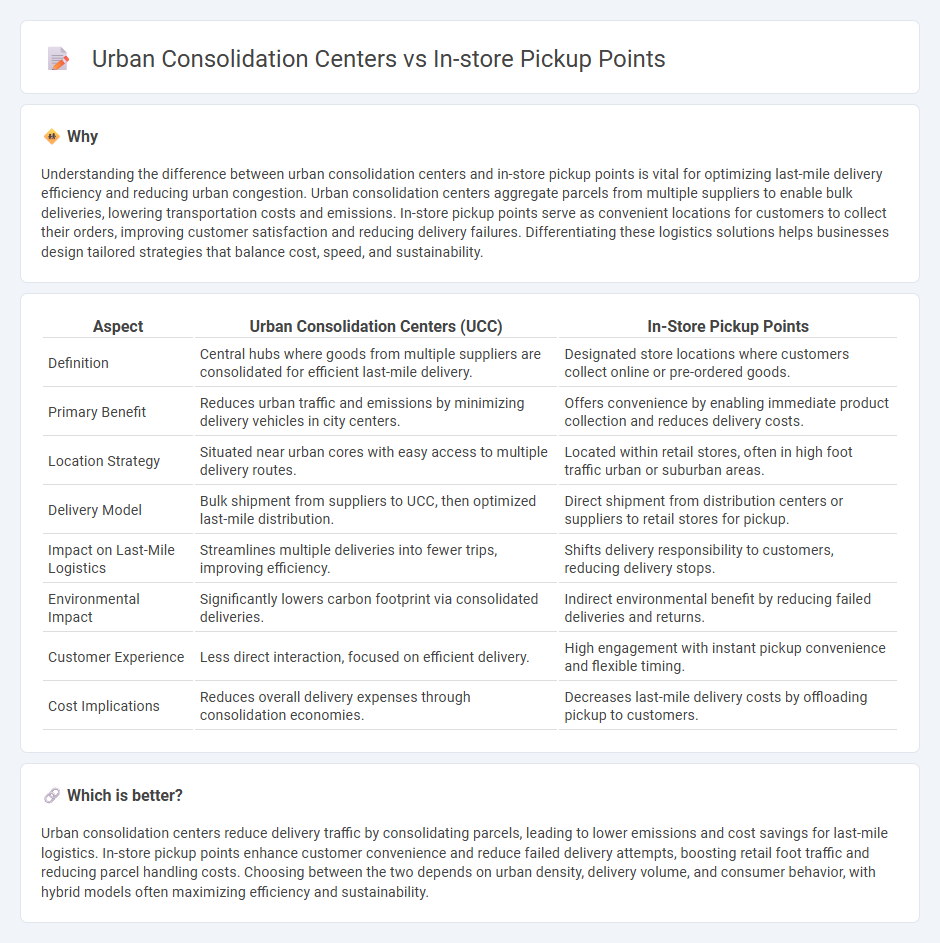
Urban consolidation centers streamline last-mile deliveries by centralizing goods from multiple suppliers, reducing traffic congestion and emissions in densely populated areas. In-store pickup points serve as convenient locations where customers collect their online orders, enhancing flexibility and reducing delivery costs. Discover how these strategies optimize urban logistics and improve customer experiences.
Why it is important
Understanding the difference between urban consolidation centers and in-store pickup points is vital for optimizing last-mile delivery efficiency and reducing urban congestion. Urban consolidation centers aggregate parcels from multiple suppliers to enable bulk deliveries, lowering transportation costs and emissions. In-store pickup points serve as convenient locations for customers to collect their orders, improving customer satisfaction and reducing delivery failures. Differentiating these logistics solutions helps businesses design tailored strategies that balance cost, speed, and sustainability.
Comparison Table
| Aspect | Urban Consolidation Centers (UCC) | In-Store Pickup Points |
|---|---|---|
| Definition | Central hubs where goods from multiple suppliers are consolidated for efficient last-mile delivery. | Designated store locations where customers collect online or pre-ordered goods. |
| Primary Benefit | Reduces urban traffic and emissions by minimizing delivery vehicles in city centers. | Offers convenience by enabling immediate product collection and reduces delivery costs. |
| Location Strategy | Situated near urban cores with easy access to multiple delivery routes. | Located within retail stores, often in high foot traffic urban or suburban areas. |
| Delivery Model | Bulk shipment from suppliers to UCC, then optimized last-mile distribution. | Direct shipment from distribution centers or suppliers to retail stores for pickup. |
| Impact on Last-Mile Logistics | Streamlines multiple deliveries into fewer trips, improving efficiency. | Shifts delivery responsibility to customers, reducing delivery stops. |
| Environmental Impact | Significantly lowers carbon footprint via consolidated deliveries. | Indirect environmental benefit by reducing failed deliveries and returns. |
| Customer Experience | Less direct interaction, focused on efficient delivery. | High engagement with instant pickup convenience and flexible timing. |
| Cost Implications | Reduces overall delivery expenses through consolidation economies. | Decreases last-mile delivery costs by offloading pickup to customers. |
Which is better?
Urban consolidation centers reduce delivery traffic by consolidating parcels, leading to lower emissions and cost savings for last-mile logistics. In-store pickup points enhance customer convenience and reduce failed delivery attempts, boosting retail foot traffic and reducing parcel handling costs. Choosing between the two depends on urban density, delivery volume, and consumer behavior, with hybrid models often maximizing efficiency and sustainability.
Connection
Urban consolidation centers streamline last-mile delivery by aggregating goods from multiple suppliers, reducing traffic and emissions. In-store pickup points complement this system by serving as localized hubs where consolidated shipments are efficiently distributed to customers. This interconnected approach enhances supply chain efficiency and urban sustainability by minimizing delivery routes and optimizing customer convenience.
Key Terms
Last-mile delivery
In-store pickup points reduce last-mile delivery costs by consolidating packages at retail locations, easing urban congestion and providing customers with convenient collection options. Urban consolidation centers centralize shipments off-site, optimizing delivery routes and decreasing emissions by minimizing multiple trips to dense urban areas. Explore further how these solutions transform last-mile logistics efficiency and sustainability.
Order fulfillment
Order fulfillment through in-store pickup points leverages local retail locations to reduce last-mile delivery costs and improve customer convenience by enabling quick and direct order retrieval. Urban consolidation centers optimize order fulfillment by aggregating parcels from multiple suppliers, streamlining deliveries to urban areas while reducing traffic congestion and emissions. Explore how these strategies can transform your supply chain efficiency and customer satisfaction.
Cross-docking
In-store pickup points enhance customer convenience by allowing immediate collection of online orders, reducing last-mile delivery challenges while urban consolidation centers optimize logistics by consolidating multiple shipments to streamline distribution through cross-docking. Cross-docking at urban consolidation centers minimizes storage time, accelerates delivery processes, and lowers transportation costs by transferring goods directly from inbound to outbound vehicles. Explore how these strategies impact supply chain efficiency and customer satisfaction.
Source and External Links
Best Buy Store Pickup - Customers choose store pickup at checkout, receive a "Ready for pickup" email when the order is ready, then bring ID and order number to the store, where orders are held for 5 days with some locations offering reserved parking and designated pickup points inside the store.
Order Online & Pick up in 20 minutes - Office Depot - After ordering for store pickup, customers receive an email notification and can pick up their items at an Online Order Station in store or choose curbside pickup where available, often with readiness in 20 minutes and potential savings on qualifying purchases.
Pickup in Store & Delivery Options | Nordstrom - Nordstrom offers flexible in-store and curbside pickup, with options to pick up the same day or next day, designated parking spots for curbside, orders held for 5 days, and an easy process for selecting stores and confirming pickup details online.
 dowidth.com
dowidth.com